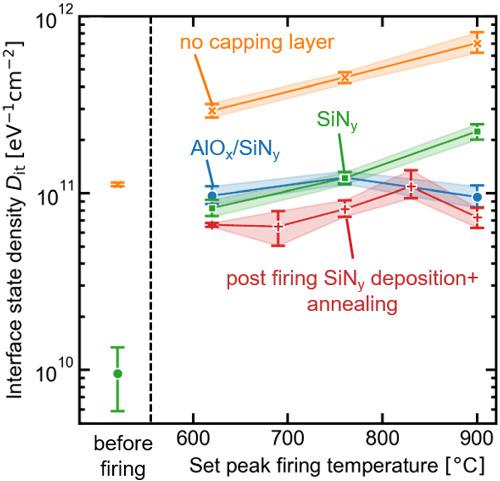当前位置:
X-MOL 学术
›
Prog. Photovoltaics
›
论文详情
Our official English website, www.x-mol.net, welcomes your
feedback! (Note: you will need to create a separate account there.)
Firing stability of tube furnace-annealed n-type poly-Si on oxide junctions
Progress in Photovoltaics ( IF 8.0 ) Pub Date : 2021-08-22 , DOI: 10.1002/pip.3459 Christina Hollemann 1, 2 , Michael Rienäcker 1 , Anastasia Soeriyadi 3 , Chukwuka Madumelu 3 , Felix Haase 1 , Jan Krügener 2, 4 , Brett Hallam 3 , Rolf Brendel 1, 5 , Robby Peibst 1, 3
Progress in Photovoltaics ( IF 8.0 ) Pub Date : 2021-08-22 , DOI: 10.1002/pip.3459 Christina Hollemann 1, 2 , Michael Rienäcker 1 , Anastasia Soeriyadi 3 , Chukwuka Madumelu 3 , Felix Haase 1 , Jan Krügener 2, 4 , Brett Hallam 3 , Rolf Brendel 1, 5 , Robby Peibst 1, 3
Affiliation

|
Stability of the passivation quality of poly-Si on oxide junctions against the conventional mainstream high-temperature screen-print firing processes is highly desirable and also expected since the poly-Si on oxide preparation occurs at higher temperatures and for longer durations than firing. We measure recombination current densities (J0) and interface state densities (Dit) of symmetrical samples with n-type poly-Si contacts before and after firing. Samples without a capping dielectric layer show a significant deterioration of the passivation quality during firing. The Dit values are (3 ± 0.2) × 1011 and (8 ± 2) × 1011 eV/cm2 when fired at 620°C and 900°C, respectively. The activation energy in an Arrhenius fit of Dit versus the firing temperature is 0.30 ± 0.03 eV. This indicates that thermally induced desorption of hydrogen from SiH bonds at the poly-Si/SiOx interface is not the root cause of depassivation. Postfiring annealing at 425°C can improve the passivation again. Samples with SiNx capping layers show an increase in J0 up to about 100 fA/cm2 by firing, which can be attributed to blistering and is not reversed by annealing at 425°C. On the other hand, blistering does not occur in poly-Si samples capped with AlOx layers or AlOx/SiNy stacks, and J0 values of 2–5 fA/cm2 can be achieved after firing. Those findings suggest that a combination of two effects might be the root cause of the increase in J0 and Dit: thermal stress at the SiOz interface during firing and blistering. Blistering is presumed to occur when the hydrogen concentration in the capping layers exceeds a certain level.
中文翻译:

管式炉退火 n 型多晶硅在氧化物结上的烧成稳定性
与传统主流高温丝网印刷烧制工艺相比,氧化物结上的多晶硅钝化质量的稳定性是非常理想的,也是预期的,因为氧化物上的多晶硅制备发生在比烧制更高的温度和更长的持续时间。我们测量了在烧制前后具有 n 型多晶硅触点的对称样品的复合电流密度 ( J 0 ) 和界面态密度 ( D it )。没有覆盖介电层的样品在烧制过程中表现出钝化质量的显着劣化。的d它的值是(3±0.2)×10 11和(8±2)×10 11 电子伏特/厘米2当分别在 620°C 和 900°C 下烧制时。D it与烧制温度的 Arrhenius 拟合的活化能为 0.30 ± 0.03 eV。这表明多晶硅/SiO x界面处的Si H 键的氢热诱导解吸不是去钝化的根本原因。425°C 的烧后退火可以再次改善钝化。具有SiN x覆盖层的样品通过烧制显示出J 0增加高达约100 fA/cm 2,这可归因于起泡并且在425°C下退火不能逆转。另一方面,在覆盖有 AlO x层或 AlO x 的多晶硅样品中不会发生起泡/SiN y堆叠,并且在烧制后可以获得2–5 fA/cm 2 的J 0值。这些发现表明,两种效应的组合可能是J 0和D it增加的根本原因:烧制和起泡期间SiO z界面处的热应力。当覆盖层中的氢浓度超过一定水平时,推测会发生起泡。
更新日期:2021-08-22
中文翻译:

管式炉退火 n 型多晶硅在氧化物结上的烧成稳定性
与传统主流高温丝网印刷烧制工艺相比,氧化物结上的多晶硅钝化质量的稳定性是非常理想的,也是预期的,因为氧化物上的多晶硅制备发生在比烧制更高的温度和更长的持续时间。我们测量了在烧制前后具有 n 型多晶硅触点的对称样品的复合电流密度 ( J 0 ) 和界面态密度 ( D it )。没有覆盖介电层的样品在烧制过程中表现出钝化质量的显着劣化。的d它的值是(3±0.2)×10 11和(8±2)×10 11 电子伏特/厘米2当分别在 620°C 和 900°C 下烧制时。D it与烧制温度的 Arrhenius 拟合的活化能为 0.30 ± 0.03 eV。这表明多晶硅/SiO x界面处的Si H 键的氢热诱导解吸不是去钝化的根本原因。425°C 的烧后退火可以再次改善钝化。具有SiN x覆盖层的样品通过烧制显示出J 0增加高达约100 fA/cm 2,这可归因于起泡并且在425°C下退火不能逆转。另一方面,在覆盖有 AlO x层或 AlO x 的多晶硅样品中不会发生起泡/SiN y堆叠,并且在烧制后可以获得2–5 fA/cm 2 的J 0值。这些发现表明,两种效应的组合可能是J 0和D it增加的根本原因:烧制和起泡期间SiO z界面处的热应力。当覆盖层中的氢浓度超过一定水平时,推测会发生起泡。











































 京公网安备 11010802027423号
京公网安备 11010802027423号